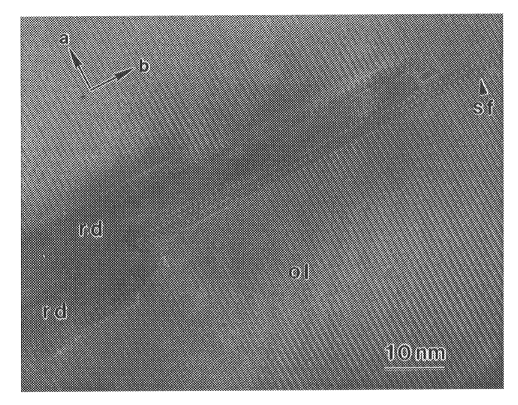

3.1 b. Intracrystalline transformation mechanism of natural olivine to wadsleyite and ringwoodite - an important mechanism for subduction zones? (L. Kerschhofer, T.G. Sharp and D.C. Rubie, in collaboration with M. Liu/Cambridge, USA)
The transformation mechanisms and kinetics of olivine (a-phase) to its high pressure polymorphs wadsleyite (b-phase) and ringwoodite (g-phase) are of great interest because of their importance for the dynamics of subduction (see Annual Report 1995, Sect. 3.1.a). For this project we have performed a series of multianvil experiments using natural San Carlos olivine (Fo90). The starting material consisted of an oriented olivine single crystal (500 x 600 x 700 µm) that was embedded in a fine-grained, hot-pressed matrix of 96% olivine and 4% enstatite (average grain size 20 µm). Samples were partly reacted in the stability field of g phase at 17 to 20 GPa and 800 to 1400°C for various reaction times (20 to 1380 min). After reaction the samples were investigated using optical and transmission electron microscopy (TEM).
The transformation occurs by two distinct mechanisms. (i) After reaction
the single crystals and the matrix olivine grains are surrounded by reaction
rims consisting of b-phase and g-phase.
These reaction rims result from incoherent nucleation on the olivine grain
boundaries and subsequent interface-controlled growth. Such a mechanism
has been observed frequently in other studies of the olivine-spinel transition
and was commonly believed to be the only transformation mechanism occurring
in subduction zones. The growth rates of the reaction rims in our samples
are not constant but decrease with increasing reaction times. Such a decrease
can be caused by the negative volume change associated with the a-b-g
transitions (~ 8% for a -> g). This volume change
causes a misfit strain during rim growth that increases with the width
of the rim. Consequently, the elastic strain energy W associated with the
misfit will also increase. Therefore, the driving force for the rim growth ![]() G, which is the balance between the chemical free energy change and W,
decreases during rim growth and finally (at
G, which is the balance between the chemical free energy change and W,
decreases during rim growth and finally (at ![]() G
= 0) the growth stops. This elastic model agrees well with the experimentally
observed reaction rim widths. (ii) Product phases are also found at intracrystalline
sites in the olivine single crystals. Many thin (several nm wide) g
phase lamellae, oriented parallel to (100)a
, are present in the single crystals and are crystallographically oriented
with olivine such that (100)a //
{111}g and [001]a
// <110>g. Their microstructures
(Fig. 3.1-2) and compositions,
G
= 0) the growth stops. This elastic model agrees well with the experimentally
observed reaction rim widths. (ii) Product phases are also found at intracrystalline
sites in the olivine single crystals. Many thin (several nm wide) g
phase lamellae, oriented parallel to (100)a
, are present in the single crystals and are crystallographically oriented
with olivine such that (100)a //
{111}g and [001]a
// <110>g. Their microstructures
(Fig. 3.1-2) and compositions,
 |
|
as investigated with high resolution TEM and analytical TEM, indicate that these lamellae nucleate coherently on (100)a stacking faults and then grow by an interface-controlled mechanism. Subsequently, the g phase lamellae act as nucleation sites for b grains. These b-grains grow to form large, optically-visible lenses which are oriented parallel to the (101)a planes.
According to the results of our experiments, kinetic models of the a-b-g transitions in subduction zones might need to be modified in two aspects: (i) Growth rates of product phases are time-dependent. Our preliminary elastic model suggests that the transformation kinetics may be to a large extent controlled by the viscoelastic relaxation of the stored elastic strain energy on a geological time-scale. (ii) Under low differential stress and P-T conditions of the mantle transition zone, olivine transforms by grain boundary nucleation and growth as well as by an intracrystalline mechanism. Both mechanisms compete and interact with each other. It is likely that intracrystalline transformation is dominant when the olivine grain size is large.

Tel: +49-(0) 921 55 3700 / 3766, Fax: +49-(0) 921 55 3769, E-mail: bayerisches.geoinstitut(at)uni-bayreuth.de
 Previous page
Previous page